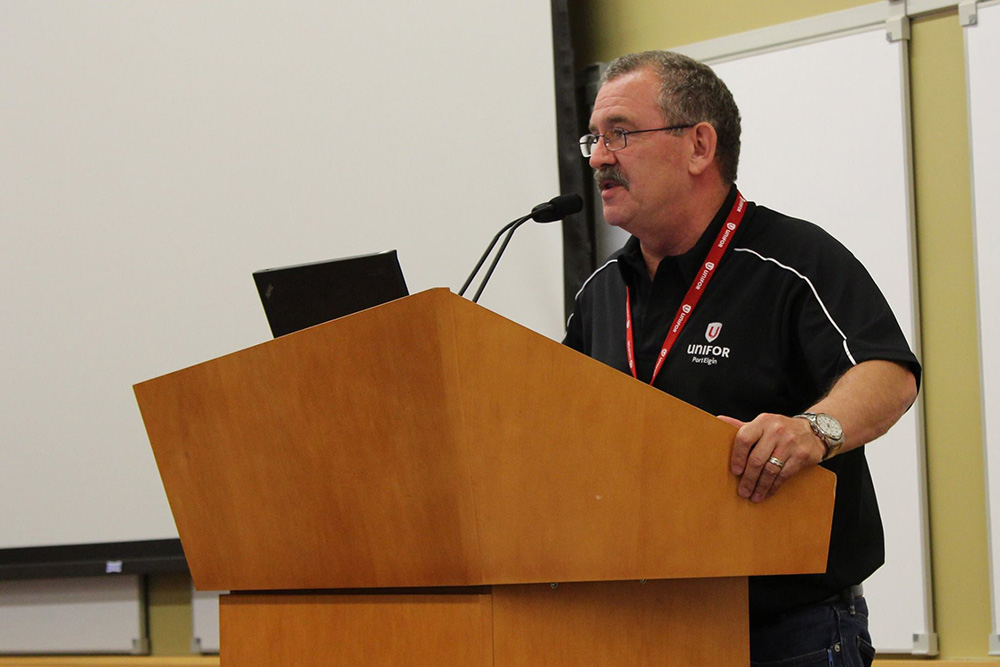Here is one worst-case climate change scenario for Canada’s upcoming federal election: The Liberals, NDP and Greens offer emissions-fighting plans that are difficult for the average voter to distinguish from one another, leading to a fractured, confused and unmotivated climate vote, while the Conservatives rile up a base unified by its single-minded opposition to climate policy.
“The great fear is that two or three parties compete over the same progressive voters and a consolidated Conservative party basically just walks up the middle and grabs a majority,” Kai Nagata, communications director for the B.C.-based Dogwood Initiative, told The Tyee.
This new federal government immediately scraps Canada’s carbon price, as Tory leader Andrew Scheer has promised. The Conservatives, which have yet to announce any plan replacing that policy, then go to work with Alberta Premier Jason Kenney and Ontario Premier Doug Ford to dismantle any environmental limits on oilsands production and fossil fuel consumption. At a time when we desperately need to be cutting greenhouse gas emissions, they go into overdrive instead.
For the next four years Canada continues to warm twice as fast as the rest of the world, smashing new records for destructive wildfires, flooding and Arctic sea ice loss. And as the global economy shifts away from fossil fuels, the hundreds of thousands of families who depend on the oilsands teeter ever more precariously on the brink of economic catastrophe — with no plan to assist them if and when demand for Alberta’s high-cost bitumen disappears.
Dogwood — along with dozens of Indigenous, labour, climate and social justice groups across the country — are racing to put forward an alternative to this worst-case scenario. With less than five months to go until the election, Canada’s climate left is trying to conjure up the grassroots progressive energy that in the U.S. has turned the Green New Deal into one of the most electrifying issues of the 2020 presidential election.
By Oct. 20, activists hope to overcome internal divisions and unify behind a made-in-Canada Green New Deal; push leaders like the NDP’s Jagmeet Singh into unapologetically aggressive positions on climate change; and elect enough politicians prepared to address the crisis that we end up with a progressive minority coalition able and ready to transform Canada’s economy.
“The history of minority governments in Canada is pretty solid, they’ve got a lot done,” Nagata said, citing the adoption of health care in the 1960s. “Mathematically it’s hard to flip a coin and land it on its edge. But it happened in B.C. [with the NDP-Green coalition] and led to some real policy shakeups.” He continued, “that’s probably my best-case scenario.”
‘This is just the beginning’
For years the mainstream thinking on how to address our climate crisis was to move cautiously. Focus on what’s politically possible, the logic went, and eventually you could grind out enough incremental policy victories to redirect our economy away from climate-destroying activities. The Pact for a Green New Deal in Canada, which was launched in May by civil society, Indigenous and environmental groups across the country, explicitly rejects that approach.
It instead takes as its starting point what the United Nations calculates is necessary for human survival: a 45-per-cent reduction in global greenhouse gas emissions by 2030. To achieve that goal in Canada, advocates say, governments at all levels should freeze fossil fuel expansion, make massive investments in low-carbon infrastructure, guarantee a well-paying green job to anyone who wants one and commit to genuine reconciliation with First Nations, Inuit and Métis communities — by, for example, fully implementing the United Nations Declaration on the Rights of Indigenous Peoples.
“This is just the beginning,” said Nayeli Jimenez, a Vancouver-based organizer with Our Time, a millennial-led climate group that is trying to make the Green New Deal central to the federal election. “We have a huge opportunity to change the future of the country.”
This may all sound like fanciful progressive daydreaming, but demanding what’s scientifically necessary rather than what’s currently feasible has in the U.S. turned climate change into a defining issue of the 2020 election primaries. Jimenez says Our Time is explicitly modelled after the Sunrise Movement, the U.S. group that launched the concept of a Green New Deal into the political discourse by getting small groups of young people to lead strategic — in some cases, viral — confrontations with establishment politicians like House Democratic Speaker Nancy Pelosi.
An example of how this might look in Canada came on March 7, when five young activists with 350 Canada showed up to a Toronto town hall event for NDP leader Jagmeet Singh and asked him if he supports a Green New Deal for fighting climate change. Singh thrilled them by giving an affirmative “yes,” though the activists left the event still wondering how committed he really is to the concept.
Then, in late May, the NDP released a 22-page climate plan titled “A new deal for climate action and good jobs.” It promises to fight global temperature rise and inequality at the same time through measures like creating 300,000 clean energy jobs over the next four years. Progressive observers such as Seth Klein called it a “bold & ambitious plan” on Twitter, while noting it remains vague on the crucial question of limiting and phasing out the production of fossil fuels.
Jimenez says to expect Sunrise Movement-style confrontations with politicians across the country in the lead-up to the October election. “We’ll start making sure every politician hears this urgency and hears what the Green New Deal means for us,” she said. “We have to move very quickly, we only have a few months to push for that narrative.”
Concerns from Indigenous activists
Eriel Deranger is more circumscribed in her enthusiasm. As executive director of Indigenous Climate Action, she was “heavily involved” in the early discussions around the Pact for a Green New Deal. Her Alberta-based group eventually endorsed it, “but it wasn’t an easy process to get to being a signatory,” she told The Tyee. “It’s not like we saw the text and said, ‘oh this is great, this includes us, it reflects our position.’”
Part of her hesitancy came from the invocation of Franklin D. Roosevelt’s New Deal. Though heavy government spending on infrastructure in the late 1930s helped lift America out of the Great Depression, most of the funding and jobs went to white people.
“A lot of people of colour and Indigenous people didn’t really benefit from the original New Deal,” Deranger said. U.S. advocates are trying to rectify this historical injustice, but groups like the Minnesota-based Indigenous Environmental Network argue that Alexandria Ocasio-Cortez’s Green New Deal resolution still doesn’t do enough to protect the rights of Indigenous communities.
When Deranger saw a draft version of Canada’s version it worried her that so much of the focus was on economic stimulus measures, rather than supporting Indigenous people fighting to keep development off lands they never ceded to the federal government. A commitment to specifically demanding that Canada respect the “Free, Prior and Informed consent and self-determination for Indigenous Peoples,” was pivotal for Deranger’s group.
But watching the federal Liberals campaign on transformative change during the 2015 election has tampered her expectations. “What actually manifested in the long-run was a very, very watered down version and in many cases a complete 180 on their promises,” she said. “So I don’t have a ton of faith in [the Green New Deal] amounting to much more than creating a public discourse.” She sees it as a useful way to galvanize public opinion and stoke grassroots intensity rather than a roadmap for politicians.
Learning from the Leap
The history of getting Canadian political parties to adopt transformative climate plans isn’t all that encouraging. When activists attempted to get the federal NDP to adopt the Leap Manifesto, a 2016 plan calling on Canada to freeze new oil and gas expansion and shift completely off fossil fuels by 2050, then Alberta NDP premier Rachel Notley called it “naive,” “ill-informed” and “tone-deaf.”
Notley had the backing of prominent labour groups like Unifor, whose president Jerry Dias said at that time that “You can't just come out with a statement that says we are going to eliminate all the use of fossil fuels,” adding that the plan gave little thought to resource “workers that have the most skin in the game.”
This tension is now playing out in the U.S., where labour union federations like the AFL-CIO have come out against the Green New Deal. Hundreds of union members turned out to protest a Los Angeles version of the plan. “If they start taking away our jobs, who’s going to pay our bills?” a 58-year-old trades worker told Politico.
Drafters of a Canadian Green New Deal took care to address this fault-line early on in the process — and it appears to be paying off. Unifor is currently supporting the framework in principle. “I think the difference between the Green New Deal and the Leap is there has been a more open discussion with labour this time around,” Ken Bondy, Unifor national representative, told The Tyee.

In those talks Unifor has stressed that retraining and buy-outs for workers affected by the shift off fossil fuels aren’t enough. “People want to be productive, they want to be in the workforce,” Bondy said. One aspect of a genuine “just transition” could be paying for workers to clean up and decommission oilsands sites — a process groups like Environmental Defence estimate could cost upwards of $51 billion.
“Those workers that know that worksite best could be employed to help leave behind a greener site,” Bondy said. “Rather than giving subsidies to corporations let’s start talking about subsidizing the workers.”
Looking to the election
At this point the Green New Deal in Canada is still a work in progress, a statement of principles and a rallying cry. But participants in over 150 town hall meetings across the country are hoping to define specifics that will have the enthusiastic backing of climate activists, Indigenous communities and labour unions.
Building a unified social movement is crucial, advocates argue, because Canada lacks an Ocasio-Cortez-type leader ensuring transformative climate action is a major political priority.
“Because we don’t have national political figures who are articulating the Green New Deal vision with the kind of boldness and convention-shattering ambition that you see in the Ocasio-Cortez-Markey resolution... we are seeing social movement forces actually take up the first push,” said Avi Lewis, who is involved with the Green New Deal movement on both sides of the border. “So that’s a very different dynamic than in the United States.”
And unlike the U.S., where activists can take advantage of a long primary process to pressure Democratic candidates for president into bold positions, Canada’s Green New Deal backers have less than five months to go until the federal election. “We don’t have the same amount of time,” Jimenez said.
Her best-case scenario is for a grassroots movement so strong and effective that it completely shifts the terms of political debate, leading MPs from the Liberals, NDP and Greens to stake out the strongest possible positions on climate change. “It’s about actually getting behind those very specific individual candidates,” she said. Then on election day, Canadians vote in enough climate leaders to form a coalition government dedicated to putting the Green New Deal into action.
Jimenez knows that a lot could go wrong with this plan. Carefully negotiated grassroots alliances could fray or fall apart. Progressive politicians could backtrack. Scheer’s Conservatives, backed by the fossil fuel industry and stoking far-right nativism, could surge forward to a majority. But to her, the Green New Deal seems like the only compelling option available.
“We have less than 11 years to cut our emissions in half, which means if we want massive political action, basically this election might be our last best chance,” Jimenez said. “I’m nervous, there’s a lot of work to do, but I’m mostly feeling fired up.”
The Tyee’s federal election coverage is made possible by readers who pitched in to our election reporting fund. Read more about how The Tyee developed our reader-powered election reporting plan and see all of our stories here. ![]()
Read more: Election 2019, Federal Politics, Environment

















Tyee Commenting Guidelines
Comments that violate guidelines risk being deleted, and violations may result in a temporary or permanent user ban. Maintain the spirit of good conversation to stay in the discussion.
*Please note The Tyee is not a forum for spreading misinformation about COVID-19, denying its existence or minimizing its risk to public health.
Do:
Do not: